I was part of a marketing community where someone shared a confusing picture. Their diagram, representing their marketing funnel, was definitely not Marketing Made Simple. It sought to provide effective follow up to every action across every communication channel.
I suspect that marketing campaign would probably be more effective than the one I will share from Donald Miller’s book, Marketing Made Simple. However, the marketing made simple book summary and marketing plan below is one that any business could implement AND it wouldn’t make a prospect feel herded down a path their don’t want to follow.
Sketchnote summary of Marketing Made Simple
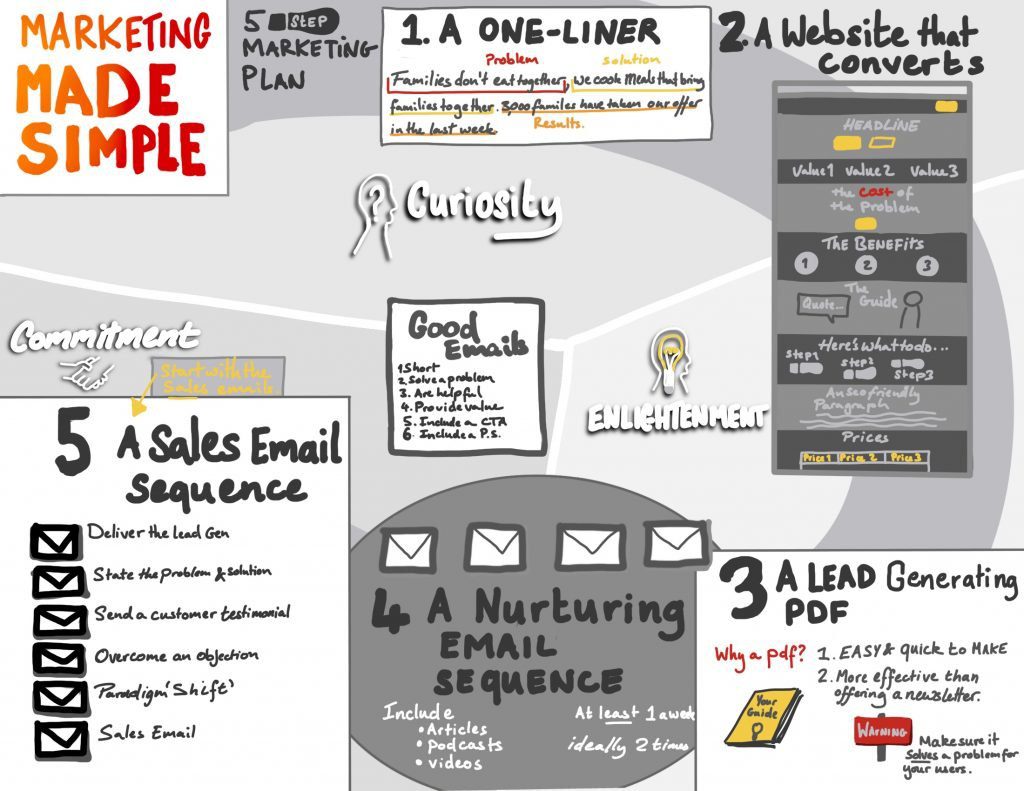
The No.1 problem with most marketing
Most companies have messages like “Save time, save money”. The problem is, that could apply to ANYTHING.
At my old job we literally used this as a test of a marketing message. Could we say it about some other computer software? If so, it was a bad message.
The appeal of the “Save time, save money” message is from it appeal to our basic instincts – Time and money are limited and we need them to survive.
While it is good to show how your product or service helps a person to survive, a message of “Save time, save money” blends in.
When any company could say the same message, a customer can choose any company.
You need to have a memorable message.
Instead of a forgettable message, you need a clear message that sticks. It needs to be something that you everyone in your company can remember and say.
Once you’ve got it, you use it everywhere and across your marketing to make sure it sticks.
Three stages in a customer journey
It’s obvious that not everyone is ready to buy from you when they first meet your company. Instead there are three stages in their journey (excluding when they don’t know you). (This is a simplified version of the classic “Stages of awareness“)
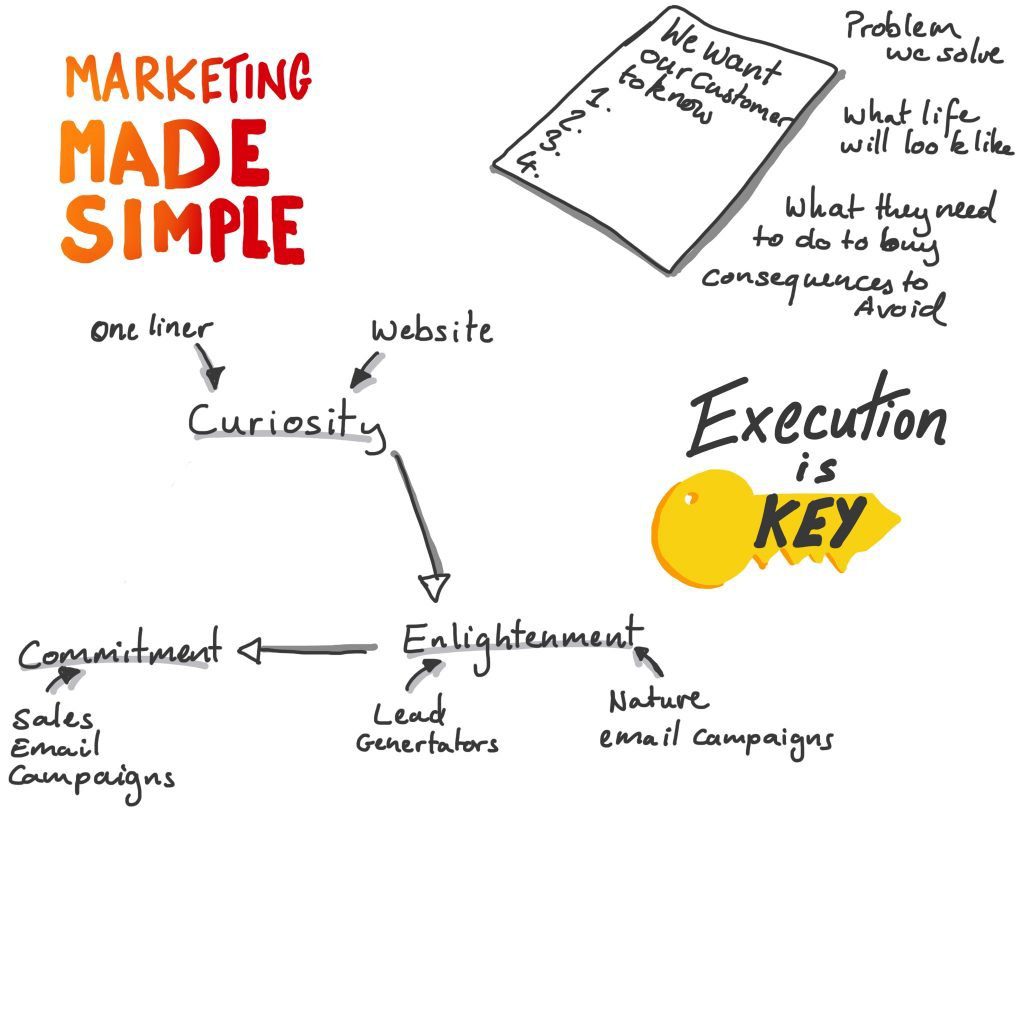
Curiosity
When you first meet someone, there’s a lot you don’t know and a lot of questions that you’ll have. You want to learn the basics about them, get to know them a bit and find out more.
Many prospects don’t go beyond this stage, they get confused or are distracted by the next curiosity. Have a clear, effective message helps.
Enlightenment
When a prospect has a moment of realization and discovery, they enter the enlightenment stage. This is where they know about you and have seen something valuable. They get how you are different and can help them with their issues.
Commitment
The final stage is when they agree to buy. To get to this point, they need to have passed through the previous two stages and be invited to go further.
How the three stages related to marketing
Curiosity – Explain who you are
Once someone has encountered you, via ads or a social post, you need to explain who you are and what you do. You do this by inviting the prospect into a story where you position your company as the guide.
This can happen in many places, but the main place is your website homepage.
Enlightenment – give value / reveal insights
The customer reaches enlightenment either by you explaining an insight or providing some value. This could be an understanding as to why they need your product or service, or how your product or service is unique and superior.
This can happen through articles, podcast episodes and emails, but an easy way is with a lead generating PDF.
Commitment – ask to buy
To get a customer to agree to buy, we must ask them. This can happen on your website, in a social post and other places but the most effective is as part of an email marketing sequence.
Execution – the key differentiator between successful and unsuccessful marketing
The problem with many marketing plans isn’t the plans, but a failure to execute the plans. It is better to have a plan which you can execute rather than a brilliant plan which can’t be realized.
The plan outlined in Marketing Made Simple may not be the most conclusive but when correctly implemented, it will be more effective than 90% of other companies marketing strategies.
The Five-step Marketing plan to make sales
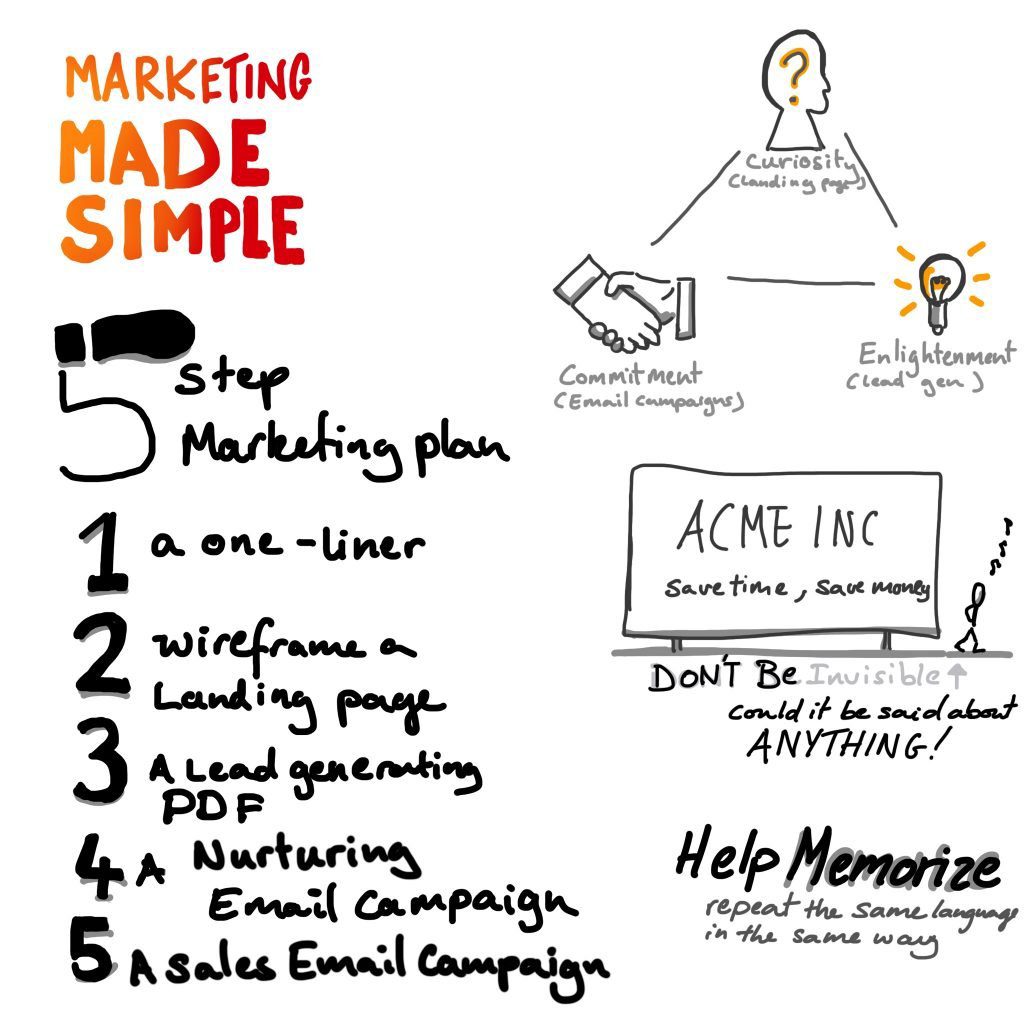
A simple five step marketing plan is all you need. It should include …
- a one liner
- wireframe a website
- a lead generating pdf
- a nurturing email email campaign
- A sales email campaign
A one liner
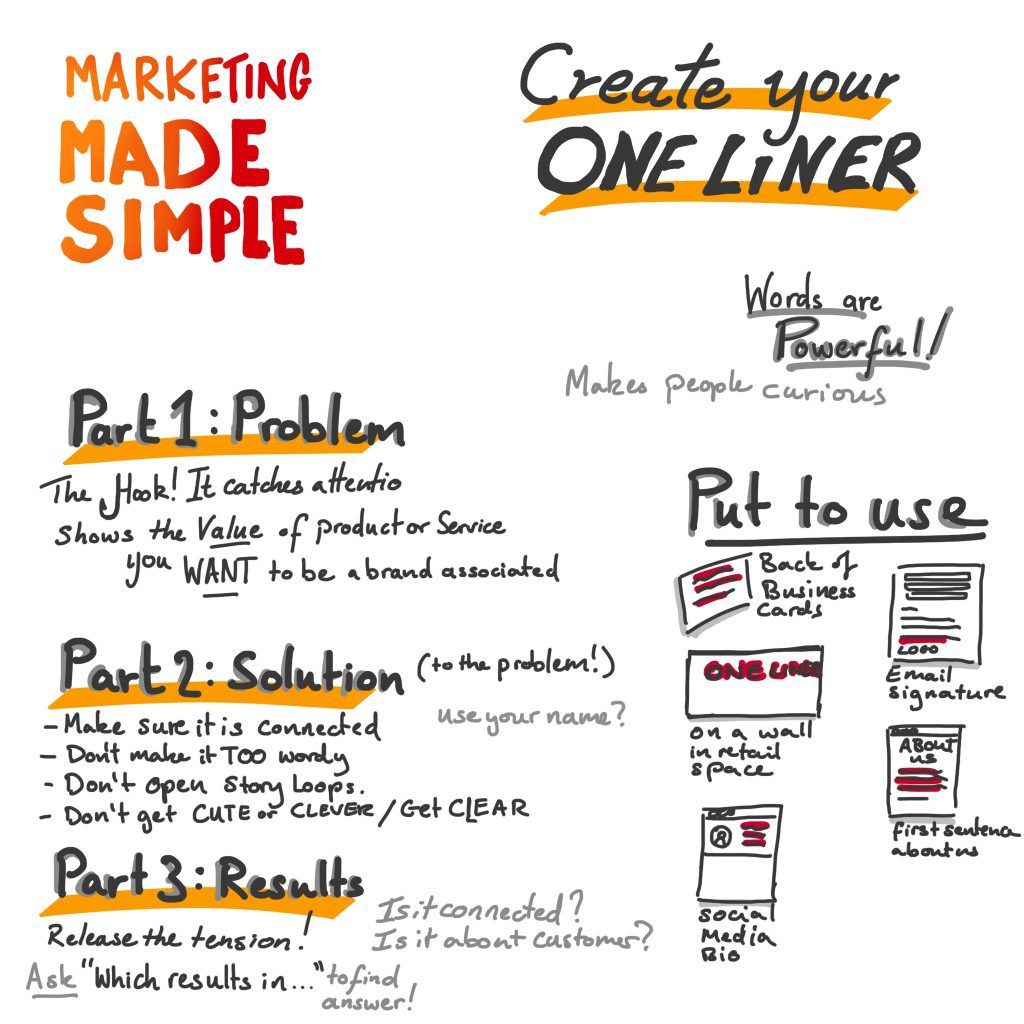
This is the short summary or elevator pitch for your business. It should be the answer to the question “what do you do?”
The simple formula is
- State the problem
- Define the solution
- Share the results.
This may be a paragraph long at first, but later you can condense it.
A website that converts
Most websites make the mistake of telling the company story or just DUMPING information on the customer.
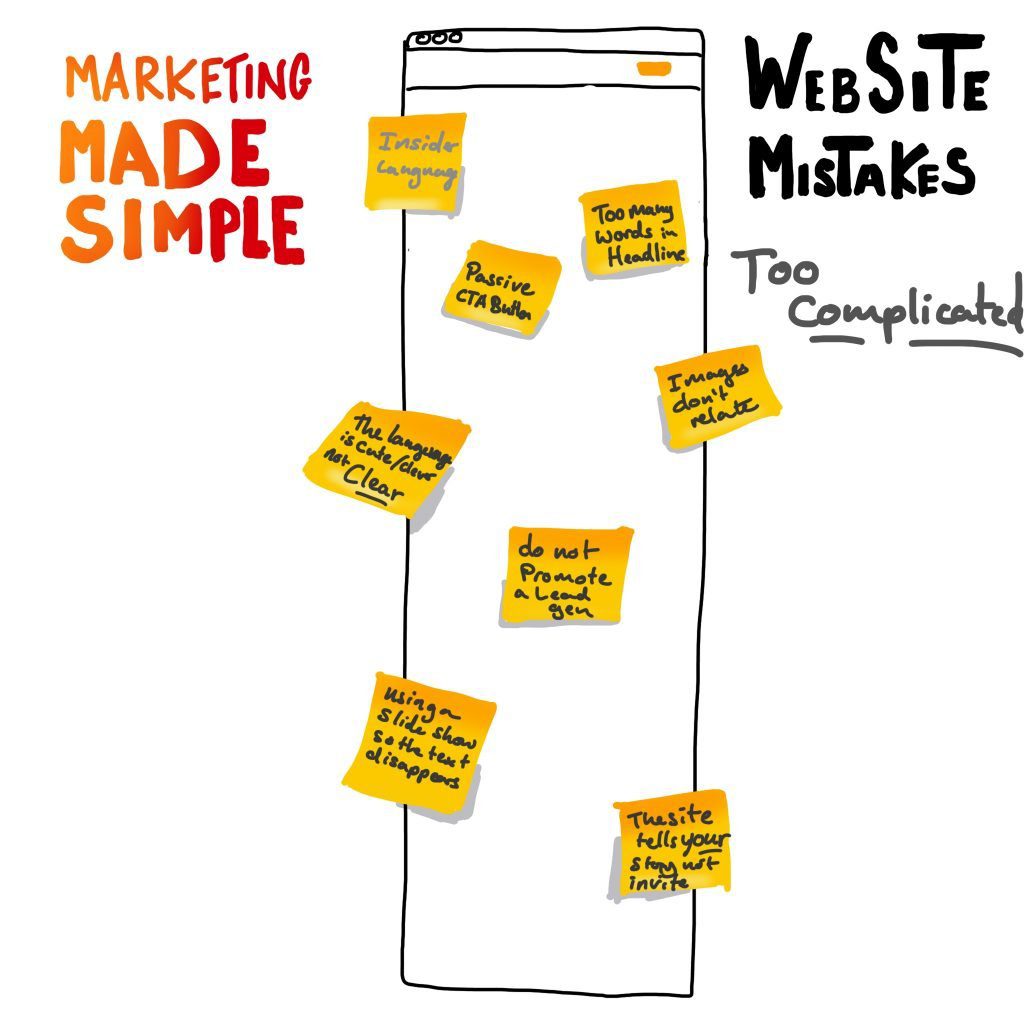
Typical website mistakes
- using insider language
- Long headlines
- It tells the company story not the customers
- And they have a confusing and unappealing offer.
A ingredients of a good website
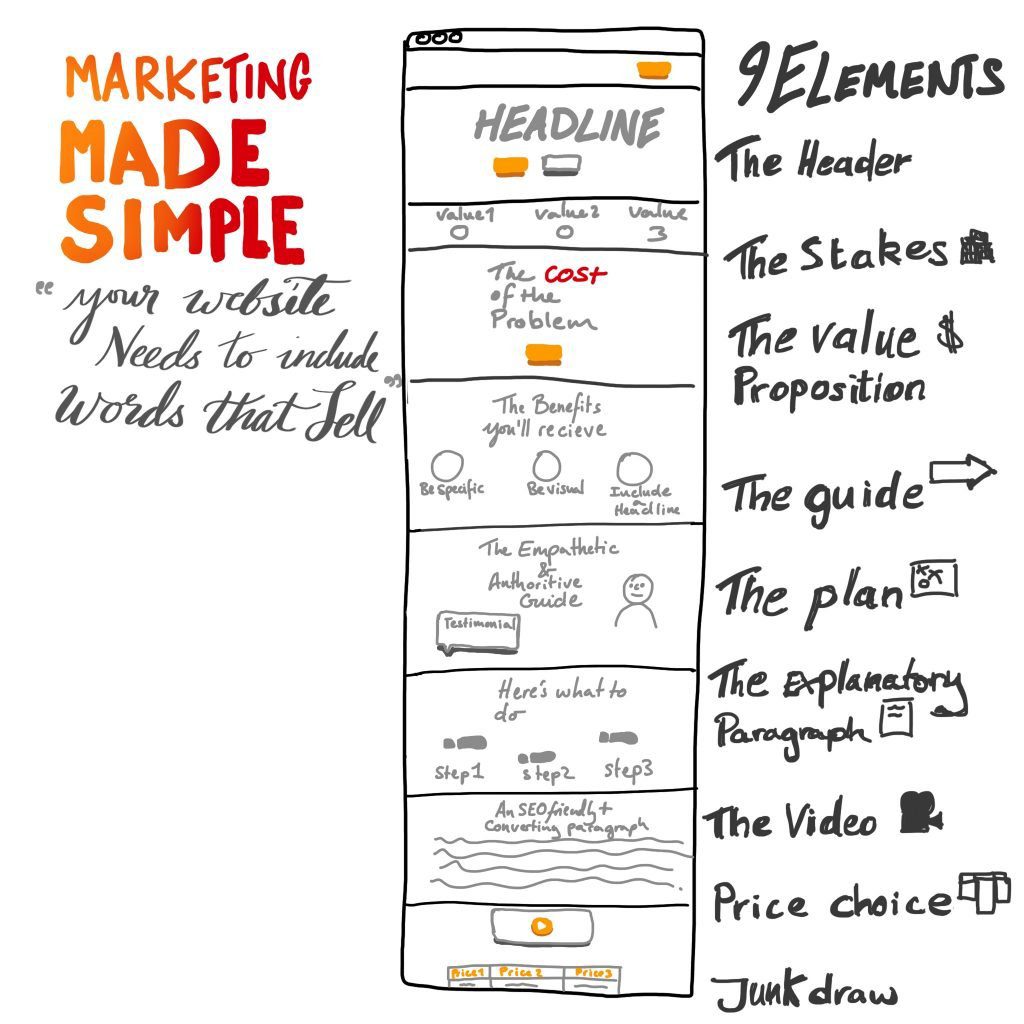
Instead, you want a website that will
- pique your prospects curiosity,
- give them a reason to go further in your marketing funnel (your lead generator)
- and provide an easy way for them to buy your product or service.
A converting website should include
- A header section – with your one-liner
- The stakes – what happens if you don’t buy
- The value proposition – what they will get
- the guide – the evidence that you can deliver
- The plan – what the customer needs to do
- An explanatory paragraph – great for SEO
- (optional) a video – helps build connection
- Price choices – An option for every budget
- the junk draw – for all the important legal stuff
A lead generating PDF
Okay, you don’t need to have a lead generating PDF, but you do need to have a lead generator, and a PDF is a low-budget, easy to produce option.
This PDF should be
- worth about $10-20
- relevant to your customers and your products – you want to “qualify” customers.
- Short – so your customer can gain value FAST.
You can, and should, experiment with different lead generating PDFs to see what resonates the most with your customers. You can also repackage PDFs in a different format (video guide/series etc) to attract different customer types.
Alternative lead gens to a PDF
People don’t sign up “to get the next newsletter”, that’s why we offered something of value in exchange their email address. But you don’t have to stick with a PDF, and one of these alternatives can stand out more.
- A short video series
- A drip email campaign
- A physical product or free sample
- an in-person event where you collect email address
- a short challenge
Whatever option you choose, make sure you give something valuable and the customer discovers your unique benefit by the end.
A nurturing email campaign that build relationships
Most customers aren’t ready to buy straight away. They…
- May need to know you are the right company for them
- Might not NEED your product or service right now
- May need to wait till they have the cash
A nurturing sequence helps customers build stronger connections with your brand so they like, know, trust you and reminds them about your offerings for when they are ready to buy.
This sequence should include
- valuable tips and insights
- customer success stories
- website Articles
- videos
- podcast episodes and interviews
It’s a good idea to email at least once a week so you stay top of mind.
If you publish a blog, podcast or videos, you can include those which will also increase the visibility of that material.
Good emails…
- Are short
- Solve a problem
- Are helpful
- Provide value
- Include a CTA (even in nurture emails)
- Include a post script – repeat the main message & summarize your content
What can you include in a nurturing email campaign?
A sales email campaign that brings in cash
In addition to your nurturing emails, you need sales emails.
Which comes first the nurturing or the sales?
Don advises starting with a sales campaign after someone downloads your lead gen. This makes sense for the customers who are ready now and looking to solve their problems soon. You don’t want to keep them waiting for your offer. (In truth, this is a small nurturing campaign).
Once a prospect has completed the sales campaign, even if they have bought, you should add them to your nurture campaign.
What goes in a Sales email campaign?
Don lays out a simple six part sales email campaign
- Deliver your lead gen – GIVE the client what you said you would.
- State the problem and the solution – This email shows you understand their issues and how you are uniquely placed to solve it.
- Send a customer testimonial – This is your chance to share how a customer overcame the same problem. It helps the reader imagine themselves in the clients shoes as well as adds credibility.
- Overcome an objection – the best way to do this is with another case study or testimonial but one that addresses a fear. “We were worried that…(objection to buying) but in the end…”
- Paradigm shift. – This is another objection overcomer but in this case its about reframing the whole issue. A common one is price. “That’s a lot of money for X!” “It is a lot of money for X, but this is so much more than X, it’s…”
- Sales email – Just sell. Don’t make a pitch, just ask the customer to buy.
The best marketing plan is the one you can implement
There are definitely more complex and fine tuned marketing plans out there. You may even be able to successfully implement one and reap the benefits. BUT, many companies miss crucial steps and end up with an incompletely plan that is more flash than substance.
The plan above is both achievable and agile so you can adjust when you notice aspects not working or need to bring a new product to market.
Get a copy of Marketing Made Simple
If you want to read the original book (instead of this marketing made simple book summary) a copy for yourself.
You might also want to check out my book summary of Social Media Success for Every Brand which is a complement to this book.

Leave a Reply